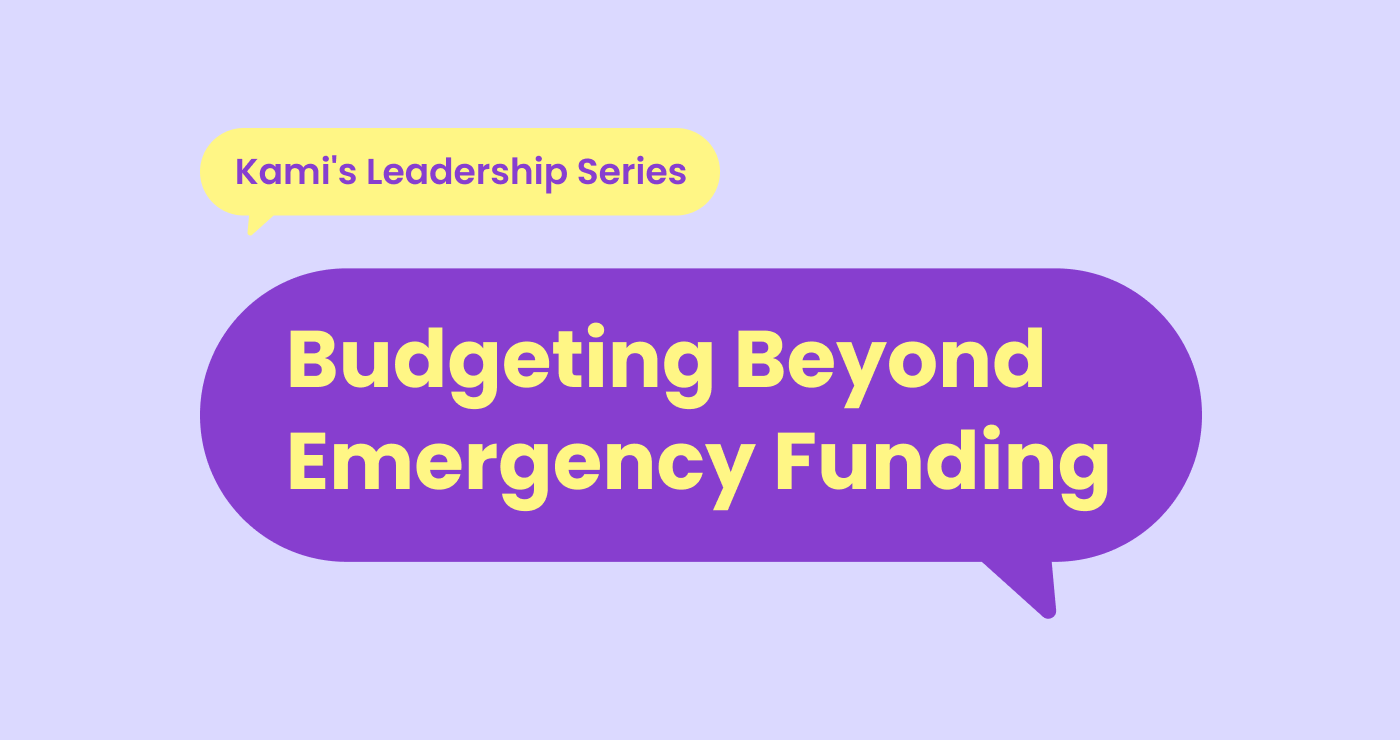Shirin Bradfield
Key takeaways
- Focus strategic planning and budgetary resources on student wellbeing and learning outcomes.
- Take caution when using ESSER funds for recurring expenditures, as these funds have a decided discontinuation date.
- Involve stakeholders in transparent decision-making processes to avoid abrupt shock and possible hostility.
We are excited to announce our new blog series focusing on leadership and decision-making in schools. We invited three of the country’s leading educational experts and former superintendents of major districts to participate in a roundtable discussion. During this conversation, they shared valuable insights and advice for decision-makers navigating the budgeting process.
Our expert panel
MaryEllen Elia | Former New York State Commissioner of Education and President of the University of the State of New York (USNY). Before her appointment in New York, Elia served for a decade as the superintendent of schools in Hillsborough County, Florida.
Dwight Jones | The president of Education Practice and Policy Partners. He has previously served as the Denver Public Schools superintendent, senior vice president of equity, inclusion, and urban markets at McGraw-Hill Education, and Clark County School District superintendent in Las Vegas, Nevada.
Dr. Michael Hinojosa | Having served as the superintendent of six public education systems for over 27 years, he retired from Dallas ISD in June 2022. Since then, he founded the Together Network for Transformation (TNT) and the Michael Casterly Institute for Aspiring Superintendents. He is also the superintendent in residence for the Council of Great City Schools.
Way back in 2020, the COVID-19 pandemic sent shockwaves through school systems nationwide, negatively impacting pupil achievement and wellbeing. With no clear end to the tremors, school leaders and the community demanded swift action from the federal government. In March 2021, President Joe Biden greenlit $122 billion in emergency K-12 funding to help schools and students bounce back.
Job done, right? Sadly not. Fast forward to the present, and schools are still figuring out how to use the money effectively. They continue to deal with a plethora of post-pandemic problems, and they lack sufficient data and clear guidance on managing student achievement and welfare. As the time to spend these federal relief funds comes to a close, we call upon our expert panel for their guidance.
Planning your budgets for the year ahead
Effective budgeting requires a delicate balance between long-term vision and immediate action. School leaders face difficulty tying budgets to district goals while maintaining the flexibility to navigate real-world changes. To help leaders and decision-makers, we asked three former superintendents how they would advise planning budgets for the year ahead.
MaryEllen Elia’s mantra for budgeting success is to “tie the resources you have to your strategic plan” and place an unwavering “focus on students.” She advocates for a forward-thinking approach, where planning for the upcoming year’s budget commences at the start of the previous year. This proactive stance allows educational institutions to identify their priorities, allocate resources accordingly, and ensure that the needs of students remain at the forefront of financial decisions.
Dr. Michael Hinojosa, however, offers a contrasting view on budgeting. He raises the specter of unforeseen events, like the pandemic, as evidence of the futility of long-term planning. While he acknowledges the value of strategic initiatives, he advises against overcommitting to long-term budgeting strategies. His perspective challenges the conventional notion that comprehensive multi-year budgets are the only way to secure an institution’s financial stability. Instead, he suggests a more adaptive approach that can respond to rapidly changing circumstances.
Dwight Jones emphasizes, “Number one on my mind is enrollment.” This sentiment resonates with Dr. Hinojosa, who said, “Enrollment drives everything.” Enrollment is a critical facet of school budgeting because it directly impacts the level of funding a school or district receives and can influence staffing decisions, class sizes, resource allocation, and program offerings, all of which have a significant impact on the quality of education and the overall budget structure of a school or district.
Jones delved even deeper into the intricacies of human capital, highlighting issues like shortages of bus drivers, substitute teachers, and other hard-to-fill positions. These real-world challenges are pivotal in shaping budgeting decisions.
Jones, much like Elia, recognizes the importance of involving stakeholders in the budgeting process. Many schools have fallen short, and according to the Center on Reinventing Public Education, more than one out of three large districts were not following the federal law requiring school systems to gather local feedback on fiscal spending.1 Equally, the National Parents Union reported in 2021 that 46% of parents surveyed had not heard about the additional infusion of funds.2 Whether it’s principals, parents, or legislators, engaging with those who have a vested interest in the success of educational institutions is essential to making informed financial decisions.
Ever the contrarian, Dr. Hinojosa challenges traditional budgeting methods by emphasizing that a significant portion of a district’s funds, around 80%, is tied up in personnel.3 He developed a board budget game to drive this point home, shedding light on the often-overlooked constraints in budgeting decisions.
In educational budgeting, it is evident that there is no one-size-fits-all approach. Elia, Dr. Hinojosa, and Jones all offer unique perspectives, reflecting the complexities of managing financial resources in an ever-changing educational landscape. As leaders in the field, their insights remind us that the key to successful budgeting lies in finding the right balance between strategic vision and adaptability in the face of uncertainty.
Section summary
- Balance long-term vision with immediate action, emphasizing tying resources to strategic plans and maintaining a focus on students.
- Maintain adaptability when creating a long-term budgeting strategy, as the educational climate may change without warning.
- Consider how, even though budget allocation centers on enrollment, human capital, and stakeholder engagement are paramount to budgeting decisions.
Navigating ESSER funds
As ESSER funds remain topical for school system leaders, we asked our former superintendents to share their perspectives on the current situation and to comment on how school systems are currently responding and how they should be responding.
MaryEllen Elia pointed out the uneven treatment of ESSER funds across different states, underscoring the critical deadlines for allocation and spending — September 30, 2024, and January 2025, respectively.3 She rings the alarm on the prevailing misnomer that education has hit a financial jackpot and points out the transient nature of this federal aid, particularly warning against its usage for recurring expenditures like teacher salaries: “Anybody that’s putting teacher salaries in ESSER has got a huge problem because the funding is going to go away.”
Dr. Michael Hinojosa echoes this sentiment, as both experts emphasize the hazards of relying on ESSER funds to cover salaries and other ongoing costs, likening it to constructing castles on shifting sand.
Dwight Jones, recalling ESSER funds as a financial savior during the pandemic, sheds light on the temporary respite they provided. Yet, he, too, joins the chorus of caution alongside Elia and Dr. Hinojosa, advising against funneling these funds into salaries or viewing them as a magical panacea for education funding woes.
Amid these warnings, Dr. Hinojosa encapsulates a pragmatic approach to fund management with a valuable mantra: “Analyze what you did. If it worked, how do you keep it? If it didn’t work, abandon it.” This analytical perspective offers a guiding light through the labyrinth of financial decisions, reminding us that adaptability and wise choices are essential in the ever-evolving world of education finance.
Section summary
- Remember the ESSER deadlines for allocation and spending are September 30, 2024, and January 2025.
- Be aware of the transient nature of federal aid and the effect of spending fiscal funds on teacher salaries and tutoring.
The funding cliff and how to avoid the precipice
The “funding cliff” enigma looms large in educational finances, casting a shadow of uncertainty over school districts nationwide. As educators grapple with the intricacies of budgetary management, we sought counsel from our three experienced leaders to glean their wisdom and insights on this critical matter.
Dr. Hinojosa’s emphasis on ‘strategic abandonment’ reverberates in Elia’s advice, as she, much like Hinojosa, suggests districts critically appraise ongoing initiatives and shelve those not living up to expectations, “You’ve got to look at the data and know these things are working.” This analytical stance could empower districts to redistribute resources where needed most, especially toward supporting students with special needs and those struggling academically.
Jones also champions the reallocation of funds toward proven, invaluable initiatives like highly effective (research-supported) academic tutoring, reflecting on past crises to underscore his point. Jones’s plea to optimize the use of ESSER funds or risk congressional backlash hints at a broader political context in which these fiscal decisions are situated. He reminds district leaders of the implications of their budgetary choices on their schools and future funding allocations.
A common thread running through the conversation is the call for proactive, forward-thinking budgetary management, underscored by a careful evaluation of ongoing programs and a subsequent reallocation of resources to ensure the sustenance of high-impact initiatives.
The conversation evidences that a one-size-fits-all approach eludes us. Elia, Dr. Hinojosa, and Jones offer unique perspectives on the intricate mosaic of financial resource management in education. They remind us that the crux of effective budgeting is striking the delicate equilibrium between visionary foresight and adaptability in an ever-shifting landscape of uncertainty.
Section summary
- Seek insights from experienced leaders to help navigate the significant challenge and uncertainty the “funding cliff” poses for school districts.
- Embrace the strategic abandonment of underachieving initiatives to enable the redirection of resources to where they can have a greater impact.
- Optimize the use of ESSER funds to balance visionary foresight and adaptability in the face of data-driven feedback.
Involving stakeholders in decisions
Since the introduction of emergency support funds, researchers have criticized schools for lacking engagement with stakeholders, especially parents and other community members, despite the federal law. Based on those interactions, we asked our experts about their experiences involving stakeholders and what advice they would offer to superintendents.
Jones recalls his tenure in Las Vegas, where the tumult of budget restrictions mirrored a national struggle, and unveils a hallmark initiative — the Open Book Portal. This online platform exposed every facet of the district’s spending, epitomizing transparency by giving even the most minor financial details to public scrutiny. Jones recounts how this unguarded honesty fostered a climate where the community rallied to support their schools, whether through foundations assisting with teacher supplies or local businesses stepping up to fill the gaps.
Elia’s time as superintendent in Hillsborough County School District has similarities to Jones’ experience. Elia underpins the importance of community involvement in budgetary affairs. Her emphasis pivots toward creating structured channels for this involvement, including teachers and parents connected to each school. Beyond the school gates, Elia expanded this dialogue across the district, organizing meetings to glean insights from all stakeholders, including teachers, parents, and community partners, employing various strategies, like storyboards and opinion surveys, to gauge opinions on various expenditures.
Jones and Elia firmly believe in opening the fiscal narrative to public commentary. Yet, the mechanisms they employ display a nuanced difference ranging from broad transparency to interactive engagement.
Dr. Hinojosa presents a narrative rooted in the boardroom, extending outward. His methodology entails engaging the community, senior staff, and school board members on the intricacies of budget formulation. This methodological transparency, Hinojosa argues, earns the trust essential for a conducive fiscal dialogue. Hinojosa underscores the importance of consistent stakeholder engagement, ensuring that budgetary decisions aren’t abrupt shocks but result from a deliberate, well-informed process.
Section summary
- Maintain transparency when engaging parents and the community in school budgeting conversations.
- Consider the different methods for opening fiscal conversations to public scrutiny, ranging from broad transparency to interactive engagement.
- Engage various stakeholders in the budgeting process and focus on trust and consistent involvement.
The Kami Advisory Group’s roundtable on school district budgeting provided a rich tapestry of insights, weaving together the expertise of three seasoned education leaders. Our esteemed guests — MaryEllen Elia, Dwight Jones, and Dr. Michael Hinojosa — each brought unique perspectives to the fore, elucidating the complexities of school district budgeting, the implications of the ESSER funds, the looming ‘funding cliff,’ and the imperative of community involvement in fiscal decisions. Their collective wisdom emphasizes the importance of forward-thinking, data-driven decision-making, transparency, and stakeholder engagement. The brightest light in our discussion was an unwavering commitment to placing students at the center of all deliberations — a sentiment we fervently share.
References
¹Bree Dusseault and Alvin Makori. How 100 large and urban districts are (and aren’t) engaging stakeholders. CRPE. Reinventing Public Education, https://crpe.org/how-100-large-and-urban-districts-are-and-arent-engaging-stakeholders/
²Parents Left in the Dark Over How Schools Are Using Federal Education Funding, National Parents Union, https://nationalparentsunion.org/2021/09/01/parents-left-in-the-dark-over-how-schools-are-using-federal-education-funding/
³Ellerson, Noelle. “School Budgets 101.” AASA, The School Superintendents Association, https://www.aasa.org/docs/default-source/resources/reports/school-budgets-101.pdf
4Dr. Daniel Domenech Executive Director AASA, The School Superintendents Association, Office of Elementary and Secondary Education, https://oese.ed.gov/files/2022/05/Late-Liquidation-Letter.pdf
You may also like

Unlocking understanding: Kami’s latest updates designed for every learner

The state of SPED and ELL technology in 2025

